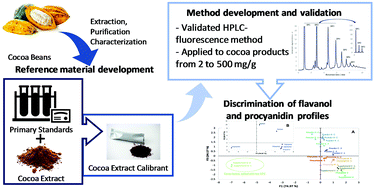当前位置:
X-MOL 学术
›
Food Funct.
›
论文详情
Our official English website, www.x-mol.net, welcomes your
feedback! (Note: you will need to create a separate account there.)
Reliable, accessible and transferable method for the quantification of flavanols and procyanidins in foodstuffs and dietary supplements.
Food & Function ( IF 5.1 ) Pub Date : 2020-01-14 , DOI: 10.1039/c9fo02762a Ugo Bussy 1 , Brian R May , Yusuf Olanrewaju , Gregory Hewitt , Nicholas Anderson , Alan Crozier , Javier I Ottaviani , Catherine Kwik-Uribe
Food & Function ( IF 5.1 ) Pub Date : 2020-01-14 , DOI: 10.1039/c9fo02762a Ugo Bussy 1 , Brian R May , Yusuf Olanrewaju , Gregory Hewitt , Nicholas Anderson , Alan Crozier , Javier I Ottaviani , Catherine Kwik-Uribe
Affiliation

|
Flavanols and procyanidins are plant-derived bioactives that are receiving increasing attention because of their potential health benefits. Analytical tools that can accurately identify and reproducibly quantify these bioactives are critical to researchers for test material characterization, as well as to the food industry and regulators, notably for product labeling. However, the chemical complexity of procyanidins, and the absence of analytical standards have prevented the development of methods that could serve the needs of these different sectors. This report describes the development and validation of a reliable, accessible and transferable method for the quantification of flavanol monomers and procyanidins in cocoa-derived dietary supplements and foodstuffs. To accomplish this, flavanols and procyandins from cocoa, one of the most studied dietary sources of these compounds, were used as a model system. To overcome limitations related to the absence of analytical standards, a cocoa extract was thoroughly characterized for use as a calibrant. It was then used in the development and validation of a method based on reliable and accessible instrumentation, namely HPLC coupled with fluorescence detection. The resulting method permitted the quantification of flavanols and procyanidins in amounts ranging from 2 to 500 mg g-1, with high precision (%RSD 0.2 to 1.9%) and accuracy (100.7 to 102.9%). The method was successfully applied to assess the flavanol and procyanidin content of different cocoa-based commercial products. Furthermore, the high precision of the methods showed the feasibility of using principal component analysis of flavanol and procyanidin profiles to discriminate cocoa-derived products by origin and manufacturing processes. A feature that offers advantages in monitoring product authenticity/adulteration. Overall, these findings support the application of this method for the routine analysis of cocoa flavanols and procyandins.
中文翻译:

可靠,可访问且可转移的定量食品和膳食补充剂中黄烷醇和原花青素的方法。
黄烷醇和原花青素是植物来源的生物活性物质,由于其潜在的健康益处而受到越来越多的关注。能够准确识别和可重复量化这些生物活性物质的分析工具对于研究人员表征测试材料,食品行业和监管机构(尤其是产品标签)至关重要。但是,原花青素的化学复杂性以及缺乏分析标准物阻碍了开发可满足这些不同领域需求的方法。该报告描述了定量分析可可来源的膳食补充剂和食品中黄烷醇单体和原花青素的可靠,容易获得和可转移的方法的开发和验证。为此,可可中的黄烷醇和原花青素,这些化合物的研究最深入的饮食来源之一被用作模型系统。为了克服与缺乏分析标准品有关的限制,对可可提取物进行了彻底表征,以用作校准物。然后将其用于基于可靠且易于使用的仪器的方法的开发和验证,即HPLC结合荧光检测。所得方法可以定量测定黄烷醇和原花青素的含量,范围为2至500 mg g-1,具有较高的准确度(%RSD为0.2至1.9%)和准确度(100.7至102.9%)。该方法已成功用于评估不同可可基商业产品中黄烷醇和原花青素的含量。此外,该方法的高精度显示了使用黄烷醇和原花青素谱进行主成分分析以按来源和制造过程区分可可衍生产品的可行性。该功能在监视产品的真伪/掺假方面具有优势。总体而言,这些发现支持了该方法在可可黄烷醇和原花青素常规分析中的应用。
更新日期:2020-02-13
中文翻译:

可靠,可访问且可转移的定量食品和膳食补充剂中黄烷醇和原花青素的方法。
黄烷醇和原花青素是植物来源的生物活性物质,由于其潜在的健康益处而受到越来越多的关注。能够准确识别和可重复量化这些生物活性物质的分析工具对于研究人员表征测试材料,食品行业和监管机构(尤其是产品标签)至关重要。但是,原花青素的化学复杂性以及缺乏分析标准物阻碍了开发可满足这些不同领域需求的方法。该报告描述了定量分析可可来源的膳食补充剂和食品中黄烷醇单体和原花青素的可靠,容易获得和可转移的方法的开发和验证。为此,可可中的黄烷醇和原花青素,这些化合物的研究最深入的饮食来源之一被用作模型系统。为了克服与缺乏分析标准品有关的限制,对可可提取物进行了彻底表征,以用作校准物。然后将其用于基于可靠且易于使用的仪器的方法的开发和验证,即HPLC结合荧光检测。所得方法可以定量测定黄烷醇和原花青素的含量,范围为2至500 mg g-1,具有较高的准确度(%RSD为0.2至1.9%)和准确度(100.7至102.9%)。该方法已成功用于评估不同可可基商业产品中黄烷醇和原花青素的含量。此外,该方法的高精度显示了使用黄烷醇和原花青素谱进行主成分分析以按来源和制造过程区分可可衍生产品的可行性。该功能在监视产品的真伪/掺假方面具有优势。总体而言,这些发现支持了该方法在可可黄烷醇和原花青素常规分析中的应用。











































 京公网安备 11010802027423号
京公网安备 11010802027423号